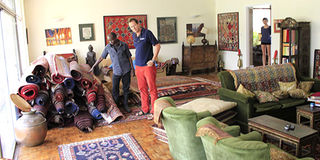Some collect stamps, others carpets

Pierce Benatar’s exotic carpet collection is worth millions of shillings. PHOTO | VERAH OKEYO | NATION MEDIA GROUP
A hunter’s thrill saw photojournalist Pierce Benatar’s rare pictures of war-ravaged Afghanistan grace the front pages of The Guardian, The New York Times and other internationally acclaimed papers a few years ago.
That very rush of adrenaline explains why Pierce is the proud owner of some of the oldest oriental carpets and rugs, stored in his house along Peponi Road near Westlands, Nairobi.
The “nomadic carpets” — the collective name for tribal rugs from Iran, Turkey, Caucasus and the central Asian countries such as Turkmenistan, Kazakhstan and Uzbekistan — are worth a fortune, and he knows it.
One of the 400 carpets, for instance, costs about Sh600,000, which Mr Benatar thinks is a bargain anyway, given it is a Lori Pambak, a hand-woven rug — normally called a Kazak — made by the Lori tribes of Iran.
Lori Pambak Kazaks measuring three by four feet may cost as much as $15,000, or Sh1.3 million. The cheapest carpet in Mr Benatar’s possession costs about Sh 18,000, and Kenyans are showing interest in his collection.
“Some, however, cannot understand why the biggest carpet here would cost far much less than a smaller one,” he says.
The interest shown by local bidders in Benatar’s collection is explained by interior designer Sam Abara, who says Kenyans are moving away from using functionality as the base when deciding what household accessories and furniture to have in their homes.
“People, for instance, want to have chairs that represent their feelings and class, not just what they can sit on alone and fill up space,” says Abara. “The same goes for carpets.”
A few weeks ago, following persistent encouragement from his daughters and wife, Benatar gathered the courage to organise a garden sale and learnt to let go of the carpets he had gathered for 15 years from various parts of the world.
“I have been to Turkey, Iran, Iraq, Somalia, Libya, Morocco... all over looking for these carpets,” he said as he laid them out in his garden.
The carpets were not bought in boutiques, he says, but in alleys, corridors and little huts of weavers in all the countries he had visited and developed contacts with.
“Surely, you can understand the attachment,” he said. “These are carpets that were made with love when a pastoralist woman in Pakistan or Afghanistan sat down and did all that work by hand, they are not uniform because each woman put a little of their creative motif here and there… all that work!”




